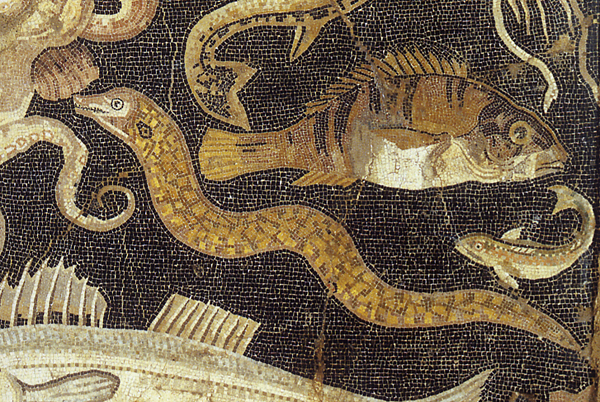Piscinae: Roman Fishponds


"The fish feel their waters shrinking as pier after pier is pushed into the sea. The contractor with his workmen repeatedly tips in rubble; at his side is the owner who is bored with living on land."
Horace, Odes (III.1.33ff)
Writing about 37 BC, Varro provides the earliest account of fish farming, although it is Columella, writing almost a century later, who gives the most detailed description, and it is in this period, from the first century BC until the end of the first century AD, that fishponds enjoyed their greatest popularity. Such a conspicuous display of wealth, common in the late republic, was discouraged by Augustus, and later emperors came to assume the prestige associated with these properties for themselves. Many fishponds were located adjacent to villas, in seaside coves and inlets or in lagoons, where they could be fed by both salt and fresh water. More expensive to construct than freshwater ponds, these coastal enclosures were often quite elaborate. Columella recommends that rocks covered with seaweed be placed in the ponds, "as far as the wit of man can contrive, to represent the appearance of the sea, so that, though they are prisoners, the fish may feel their captivity as little as possible" (On Agriculture, VIII.17.6).
As Varro asserts, the appeal of fishponds is to the eye rather than the purse, which is emptied rather than filled by them. "For in the first place they are built at great cost, in the second place they are stocked at great cost, and in the third place they are kept up at great cost" (On Agriculture, III.17.2). Even though these were saltwater ponds, fresh water was used to control salinity and temperature and, more importantly, to create the brackish mix of salt and fresh water so favored by fish. Channels, such as those constructed by Lucullus, facilitated the circulation of seawater, larger ones directly from the ocean and smaller ones to distribute the water within the fishpond, where shaded areas and amphorae stuck in the walls provided the illusion of security (Varro, III.17.9ff; Columella, VIII.17ff). To prevent the fish from escaping, brass gratings were placed across the channels. Cicero has no patience for all this extravagance, calling aristocrats such as Lucullus and Hortensius piscinarii ("fish fanciers") and "Tritons of the fish ponds" (Ad Atticum, I.20, I.19, II.9).
Although seaside fishponds could be excavated from rock, they more commonly were constructed using a hydraulic concrete composed of volcanic ash (pozzolana), lime, and aggregate. Hardening when mixed with water, this concrete also was used for the moles or breakwaters that served as a barrier to protect and define the perimeter of the fishpond. Lucullus was said to have built massive piles into the water and even to have cut a channel through a mountain near Naples to let in the sea, which prompted his rival Pompey to call him a "Xerxes in a toga," recalling the channel that had been cut through the isthmus at Mount Athos by the Persian king (Pliny, Natural History, IX.lxxx.170; Velleius Paterculus, Compendium of Roman History, II.33).
Such moles extended the property of the villa and, because they belonged to the owner, extended possession to the water, itself. The Digest of Justinian is quite explicit on this point. "What a man erects on the seashore belongs to him; for shores are public, not in the sense that they belong to the community as such but that they are initially provided by nature and have hitherto become no one's property. Their state is not dissimilar to that of fish and wild animals which, once caught, undoubtedly become the property of those into whose power they have come" (XLI.14). Fishponds, therefore, not only were a conspicuous display of wealth and an aesthetic pleasure but allowed the aristocratic Roman to acquire control over nature, itself, both on land and sea. It was, as Columella commented, an age in which "the extravagance of the wealthy enclosed the very seas and Neptune himself" (VIII.16.3).
The mosaic is in the Museo Archeologico Nazionale di Napoli (Naples) and dates to about 100 BC. Like the fishponds themselves, such delicate arrangements of very small tiles (tesserae) were extremely expensive to produce.
References: Piscinae: Artificial Fishponds in Roman Italy (1997) by James Higginbotham; Lucius Junius Moderatus Columella: On Agriculture (1941-) translated by Harrison Boyd Ash and by E. S. Forster and Edward H. Heffner (Loeb Classical Library); Marcus Porcius Cato: On Agriculture and Marcus Terentius Varro: On Agriculture (1934) translated by William Davis Hooper, revised by Harrison Boyd Ash (Loeb Classical Library); Cicero: Letters to Atticus (1999) translated by D. R. Shackleton Bailey (Loeb Classical Library); The Digest of Justinian (1985) edited by Alan Watson; Velleius Paterculus: Compendium of Roman History (1924) translated by Frederick W. Shipley (Loeb Classical Library).
![]()